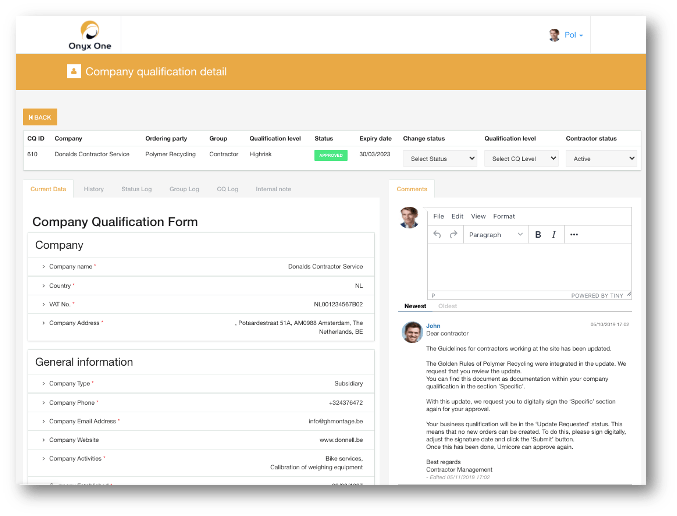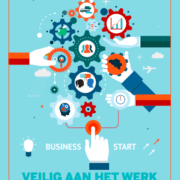
[av_icon_box position=’top’ icon_style=” boxed=” icon=’ue83e’ font=’entypo-fontello’ title=’Restart safely’ link=” linktarget=” linkelement=” font_color=’custom’ custom_title=’#000000′ custom_content=” color=’custom’ custom_bg=’#e4a93d’ custom_font=’#ffffff’ custom_border=” custom_class=” admin_preview_bg=”][/av_icon_box]
What should be taken into account during and after restarting
Working with third parties
Do you work with contractors and sub-contractors? As a hiring client, you have a legal responsibility to protect third parties against health and safety risks. This means that you must think about the risks they run and minimize them as much as possible. Don’t be mistaken, this risk analysis is not about creating large amounts of paperwork, but about identifying meaningful measures to manage the risks on your site.
Make clear agreements and communicate your measures and instructions in a timely manner. After all, third parties must use the same working methods and receive the same instructions as your employees.
Do you want the restart measures to be respected? Make sure your contractors are confronted with your communication in every possible way. Putting up posters and sending out an e-mail is not enough. Use all possible channels to point out the importance of the measures you put in place.
Designate a person responsible for all corona-related matters who will monitor communication with contractors and act as the first point of contact. Motivate contractor companies to ask questions. Make sure a specific telephone number is available to contractors. To ask questions, but also to inform you (e.g. we’re running out of soap in room 3). And lastly, make sure that your restart measures are available in the contractor’s native language.
Risk management, policies and procedures
It’s your duty to limit the risks on your site and in every workplace to the lowest possible level by taking preventive measures. In addition to introducing guidelines on frequent washing and cleaning of surfaces, you must ensure that your contractors can work separately as much as possible. If this is not the case and the job cannot be postponed, then keep the following guidelines in mind:
- Increase the frequency of hand washing and surface cleaning (even more).
- Limit the activity time.
- Use screens or barriers to separate people.
- Make sure contractors are working back to back or side by side whenever possible (instead of face-to-face).
- Reduce the number of people each person has contact with by using permanent teams.
Ask about the health of your contractors
Ask contractors who have a higher risk of serious illnesses (e.g. people with some pre-existing illnesses) to be extra careful in respecting the guidelines. If possible, assign them the safest role. Assess carefully whether the job poses an acceptable risk. Also check in advance whether your contractors live with people at high risk. At all times, before, during and after the job, provide the necessary support by telephone, e-mail or via your contractor platform.
Use a checklist during your qualification process
Your contractor management system Onyx One allows you to add a Covid-19 checklist that is automatically opened for each contractor that the contractor company assigns to a job. This checklist can be completed by the client or by the contractor. The questions are not standard but are determined by the hiring client.

Arriving and leaving the site
- Try to spread the arrival times of your contractors to reduce the hustle and bustle on the site in the morning.
- If possible, offer extra parking space and implement rules to limit the number of passengers in cars, minibuses and vans.
- Explore the possibility of opening multiple access points to the workplace.
- Use markings to ensure one-way traffic at entry and exit points.
- Provide hand washing facilities, or hand sanitizers where this is not possible, at boarding and alighting points.
- Find alternatives or solutions for touching surfaces such as keyboards and computer screens.
Movements
- Reduce non-essential movements within buildings and between locations. For example, by restricting access to certain areas and encouraging the use of telephones.
- Reduce the rotation of equipment.
- Implement a one-way system on walkways around the workplace.
- Use signage such as ground markings to allow a controlled flow of people moving around the site.
- Reduce the occupancy of vehicles used on site.
- Divide your site into work zones to keep different groups of employees physically separated as much as possible.
- Reduce the number of people present on the site if possible.
- Regulate the use of high-traffic areas such as corridors, elevators and turnstiles.
Meetings
Try to keep physical meetings to a minimum and choose online meetings if possible. If physical meetings are necessary, keep the following things in mind:
- Invite only absolutely necessary participants and respect the prescribed distance.
- Avoid transmission during meetings, for example sharing pens and/or other objects.
- Provide hand sanitizers.
- Hold meetings in the open air or in well-ventilated areas whenever possible.
Common areas
Set shortened and rotating pause times to reduce pressure on pause areas or dining areas. Use safe outdoor areas if possible. Creating extra space by using other parts of the workplace is also an option. Consider reconfiguring seats and tables to preserve space and reduce interaction between people.
The importance of good communication
Communicating clearly in advance with your contractors ensures greater safety and smoother cooperation. Use all available channels to get your message across: your contractor system, your website, e-mail or telephone.
- Send your contractors COVID-19 related updates on the areas your company is active in.
- Chop your communication into small pieces (long mails are often not read carefully) and repeat your message several times (and if possible, in other ways). In this way you increase your chances of success.
- Use test systems (such as e-Learning) to check whether your message has been understood.
On-site communication
Make sure your contractors understand what they need to do to work safely.
- Public announcements should be clearly visible.
- Provide eye-catching signage.
- Communicate clearly about rights of way in the workplace.
- Provide a central telephone number contractors can call to ask questions and make comments. Post this number in every workplace.
Communication via your contractor management system onyx One
Thanks to Onyx One, hiring clients easily communicate with all their contractor companies at once, with contractors individually or with a group of them. The complete communication history is registered under the company qualification. In addition to sending out messages, you can ensure that your Covid-19 guidelines are linked to a status change in the qualification process. This means that the contractor is obliged to sign and resubmit these measures online before he gets access to your site.
Testing contractors with your contractor management system onyx One
It is also possible to assign a COVID-19 training to a specific job or to all your contractors. This means that third parties follow an online training course (or complete an online questionnaire) before they gain access to your site.
Hygiene: a clean workplace
Greater safety starts with a clean workplace. We all know the rules by now, but let’s repeat them once more:
- Frequent cleaning of the workstations and equipment, especially when relieving the guard, using your usual cleaning products.
- Frequent cleaning of objects and surfaces that are regularly touched, such as buckets, yard equipment and control panels, and ensuring adequate drainage control.
- Clearing work areas and removing waste and belongings from the work area at the end of the shift.
- Decontaminating all hand tools, controls, machinery and equipment after use.
Hygiene: hand washing, sanitation and toilets
- Use signs and posters to inform about the correct hand washing technique.
- Send reminders and use signage to maintain hygiene standards.
- Provide hand sanitizers at all locations.
- Establish clear use and cleaning guidelines for toilets (cleanliness and frequency of use).
- Don’t forget to clean portable toilets.
- Organize more frequent garbage collection.
- Provide paper towels or electric dryers.
Hygiene: changing rooms and showers
- Establish clear cleaning rules.
- Prohibit leaving personal belongings behind.
- Limit the period of use.
- Do frequent checks.
Useful information
Where can I find the generic guide?
The social partners of the High Council for Prevention and Protection at Work, the Policy Unit of the Minister for Employment and experts from the FPS Employment have worked out a generic guide in order to assist businesses in the gradual relaunch of economic activities. View or download the guide by clicking on the image. Attention! The guide is only available in Dutch or French.

Where can I find reliable and up-to-date information?
Via VBO (D/FR), VOKA, (D), the FPS Public Health and Sciensano, you will find reliable and up-to-date information about all measures, as well as on the site of technology federation Agoria (D). In addition, check the travel advice for your export destinations.
A selection of interesting articles:
- Temporary unemployment (D/FR – The Federation of Belgian Enterprises VOKA)
- Frontier workers (D/FR – The Federation of Belgian Enterprises VOKA)
- Relaunch plan for the labour market (D – Flemish Network of Enterprises)
- Reboot safely together (D- Flemish Network of Enterprises)
- Impact of the corona crisis on Belgians: results of the 2nd COVID-19 health survey (D/FR – Federal Public Health Research Centre Sciensano)
How can I draw up an action plan?
This checklist of the External Service for Prevention and Protection at Work Mensura can help to draw up an action plan for the recovery or continuation of non-critical activities with the aim of returning to a normal situation (such as before the lockdown).
-
- Designate a coordinator or coordinating team for central control.
-
- Determine which activities will start up again and which departments/locations will open first.
- Check whether suppliers, distributors, partners, contractors are working.
-
- Draw up a declaration of commitment for your own employees.
- Draw up a declaration of commitment for third parties.
-
- List the measures to be taken in regard to the reception of people on your site.
- List the necessary measures concerning the workshop.
- List the measures to be taken regarding maintenance.
- List the measures you must take concerning your employees.
- List the measures you will take regarding third parties.
- Ensure the risk analysis of workstations has been adapted.
-
- Inform people about the measures in various ways everywhere in your company and/or on construction sites. Think of posters, signs, floor markings, …
- Inform the necessary consultative bodies about the preventive measures taken.
- Inform contractors, suppliers, distributors, partners, … about the relaunch of your activities and the measures taken.
-
- Use digital means of communication as an alternative to start-up meetings (training, toolbox, clarification of specific business measures)
-
- Monitor compliance with the measures
- Encourage open communication for behavioral change
- Strictly follow the guidelines regarding sick employees
Restarting: Guidelines per sector

Onyx One is not just contractor management software, it is a contractor platform / contractor community, developed at the request of and in cooperation with the industry. It is a functional and simple system that facilitates the qualification of, and the collaboration with contractors and subcontractors.